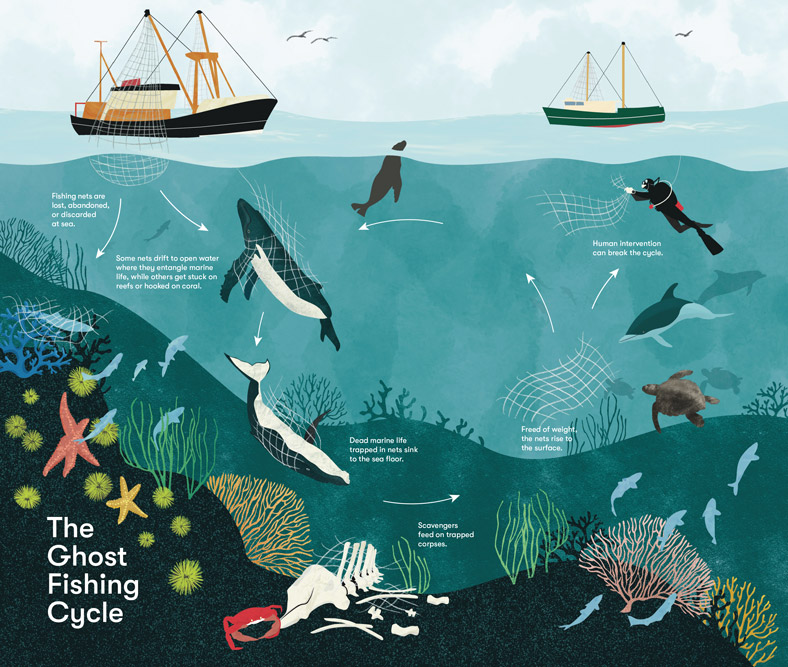
A specter more frightening than microplastics haunts our oceans.
Ghost gear—fishing equipment like nets, traps, and ropes that are lost, abandoned, or discarded—is the deadliest form of marine debris, affecting more than 40 percent of aquatic mammals, including endangered species like sea turtles. Studies estimate that ghost gear comprises 70 percent of floating macroplastics by weight in the five oceanic gyres. Nearly half of the plastic contents in the most well-known gyre—the Great Pacific Garbage Patch, an archipelago spanning 620,000 square miles—is fishing gear.
Even though the problem is pervasive—more than one ton of gear disappears every minute—it is, as its name suggests, a largely invisible demon. Jaclyn McGarry’s job is to reveal what’s out of sight and make it top of mind.
As a manager of the first-of-its-kind Global Ghost Gear Initiative (GGGI), McGarry, CAS/BS ’13, works with more than 100 stakeholder groups, including nonprofits, research organizations, corporations, and 18 national governments, to retrieve lost fishing gear, build the world’s most robust dataset on the problem, identify new policies for preventing the problem, and develop innovative technologies to prevent future losses.
“I have a passion-fueled love for the ocean,” McGarry says. “I was a military kid and for the first half of my life, wherever we lived, it was by the ocean.” After watching a documentary at AU about sustainable fishing, the biology and film and media studies major had an epiphany: “I didn’t have to be a marine biologist in a wetsuit to make a difference.”
After stints with the Ocean Conservancy, the North Carolina Costal Federation, and the National Marine Sanctuary Foundation—during which she earned a master’s in coastal environmental management from Duke University—McGarry was lured back to Ocean Conservancy in 2019, the same year the DC-based nonprofit began hosting GGGI.
Founded in 2015 by World Animal Protection, GGGI has partnered with local fishers around the world, from the South Pacific to Panama City to the Gulf of Maine—where McGarry supported lobstermen using sonar technology to remove two tons of gear from Casco Bay last September. (Only two years earlier, GGGI made a whale of a discovery off Cape Elizabeth, Maine: a 20,000-pound gear ball so large it had to be towed to shore to be dismantled.)
“Fishers are our most important partners. Many of them have been doing this longer than I’ve been alive, and they have a wealth of knowledge,” she says. “They’re the first to say: ‘I helped create this problem, I want to fix it.’”
Unlike a plastic bottle that’s carelessly tossed in wrong bin—taking up to 450 years to decompose—the vast majority of the 640,000 tons of ghost gear that disappears each year does so by accident, snagging beneath the surface or tangling with another fisher’s equipment or vessel.
Severe weather is also a common culprit. “A lobsterman puts his gear in the water for two or three days, harvests the pots, and resets them,” McGarry explains. “But a storm can move the pots miles away. In the vastness of the ocean, that’s a huge problem.”
As are the impacts of disappeared gear on marine life and the livelihoods of fishers.
Nets are typically made of top-of-the-line nylon that doesn’t break down easily. They can continue to “fish” for years, capturing ocean-dwellers and entangling marine life that flock to feed on them—thus spawning a vicious circle that’s broken only by human intervention. Ghost gear can also damage coral and vegetation and trap sediment.
According to GGGI, ghost gear is responsible for up to a 30 percent decline in stocks, depending on fishery and location, which impacts the millions of humans who catch them and consume them. (About 25 percent of the world’s population relies on fish as a primary source of protein.) Replacing gear can eat into fishers’ already tight profit margins: World Wildlife Foundation, a GGGI member organization, reports that replacement of lost gear costs one crab fishery in British Columbia nearly $500,000 each year.
When it comes to ghost gear, “there’s no silver bullet, no one-size-fits-all solution,” McGarry says. “It requires the expertise of everyone.” Connecting those experts in all corners of the globe to develop practical, sustainable, and hyper-localized strategies is one of the highlights of her job.
“You can have someone from Myanmar saying, ‘We have this problem with nets, how do you remove them?’ Then you have someone in Nigeria saying, ‘This is what we’ve done’ and someone in London offering up helpful research,” McGarry says. “Seeing passionate people be successful and do good work is my favorite part of the job.”
Ghost gear may be largely out of sight, but thanks to changemakers like McGarry, it’s a problem that’s increasingly on our radar.